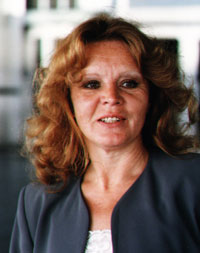 |
Janina Baranowska-Kortylewicz, Ph.D. |
UNMC researcher Janina Baranowska-Kortylewicz, Ph.D., wants that to change.
Dr. Baranowska-Kortylewicz has developed a series of drugs that seek and kill ovarian cancer cells that are responsible for the recurrence of the disease.
“Our drugs represent a brand new class of radiopharmaceuticals that are cancer-specific and that can target the most aggressively growing tumors,” she said. “More importantly, their effects on tumor growth are not hampered by the emergence of a drug resistant disease.”
UNeMed, the marketing and licensing arm of UNMC, is in negotiations to grant an exclusive license to commercialize the technology, said Jack Hartwigsen, Ph.D., senior licensing associate for UNeMed. Efforts also are underway, he said, to secure outside funding to further the work through a sponsored research agreement with industry.
On Aug. 23, Dr. Baranowska-Kortylewicz will join other UNMC inventors in the Durham Research Center Auditorium for UNeMed’s 2007 Research Innovation Awards. The ceremony, which will recognize inventors for their new inventions, patents and licensed technologies, begins at 4 p.m. A reception will follow in the DRC Atrium.
“Nina has developed a truly unique approach to delivering cytotoxic radiation to cancer cells,” Dr. Hartwigsen, said. “For her efforts, she is recognized by industry as a pioneer in her field.”
The essence of Dr. Baranowska-Kortylewicz’s technology is the selective delivery of highly cytotoxic compounds to cancer cells. The direct action of these compounds on DNA bypasses all genetic and molecular defense mechanisms of cancer cells and does not allow these cells to evade irradiation and death..
“This escape mechanism is what ultimately leads to the failure of many cancer therapeutics,” Dr. Hartwigsen said.
Patients with ovarian cancer generally experience a progressively shorter disease-free interval after each course of therapy, Dr. Baranowska-Kortylewicz said. The recurrence of chemoresistant ovarian cancer is usually fatal because response rates to existing treatment modalities are low. Over time, cumulative toxicities and the development of a multi-drug resistant disease prevent further treatments, she said.
In designing new drugs for the treatment of ovarian cancer, Dr. Baranowska-Kortylewicz’s team developed a built-in targeting component that seeks a specific receptor expressed in more than 90 percent of advanced and relapsed ovarian cancers.
“New drugs are virtually nontoxic to normal tissues but extraordinarily deadly to tumor cells that accumulate these drugs,” she said. “Cancer cells that divide rapidly will take up more of the drug and will be destroyed.”
The distribution of the drug to normal tissues is reduced and the potential for systemic toxicity is diminished — possibly even eliminated, she said.
She is quick to credit the work of her UNMC team, including organic chemist and co-inventor Zbigniew Paul Kortylewicz, Ph.D., who designed the synthetic and analytical methods and prepared the new drugs. The accomplishments of the J. Bruce Henriksen Cancer Research Laboratories at UNMC, where the new drugs were developed, she said, also occurred thanks to the support of Charles Enke, M.D., chairman of UNMC’s Radiation Oncology Department.
A professor at UNMC since July 1995, Dr. Baranowska-Kortylewicz encourages fellow inventors to consult with UNeMed representatives and seek advice from colleagues.
“The staff of UNeMed is working tirelessly to accomplish the difficult task of translating our ideas into commercially viable products,” she said. “The potential of these drugs to succeed as a new therapeutic approach in the management of advanced ovarian cancer is high.”